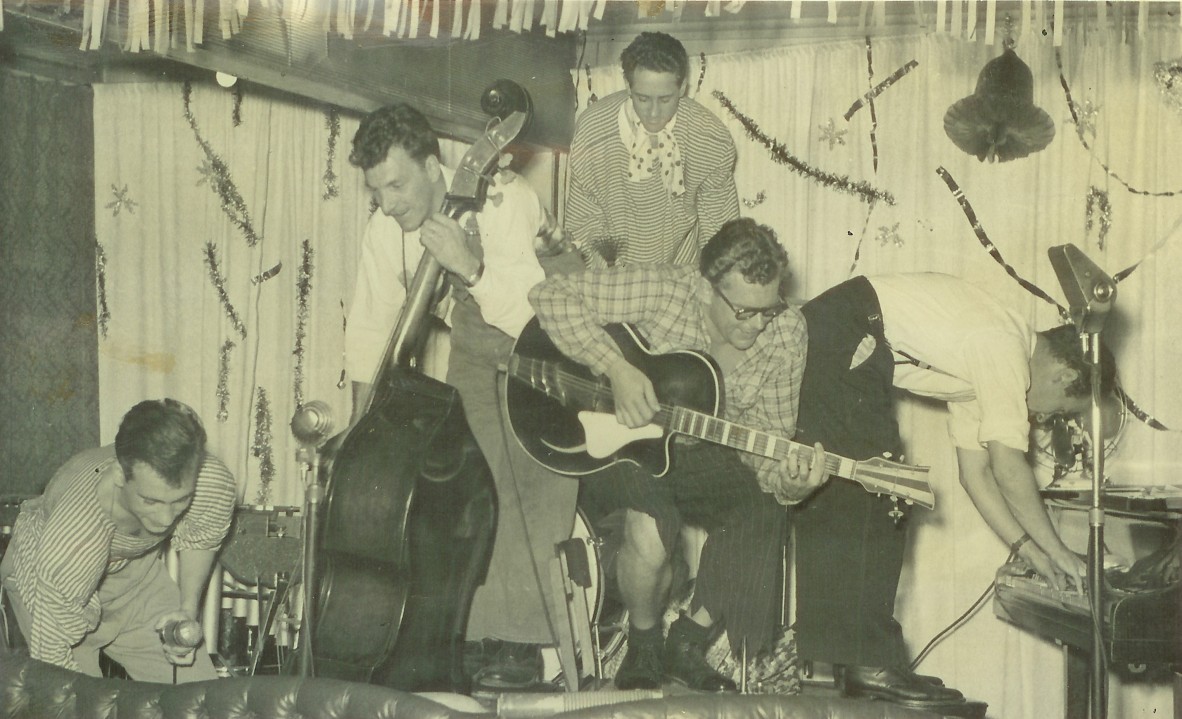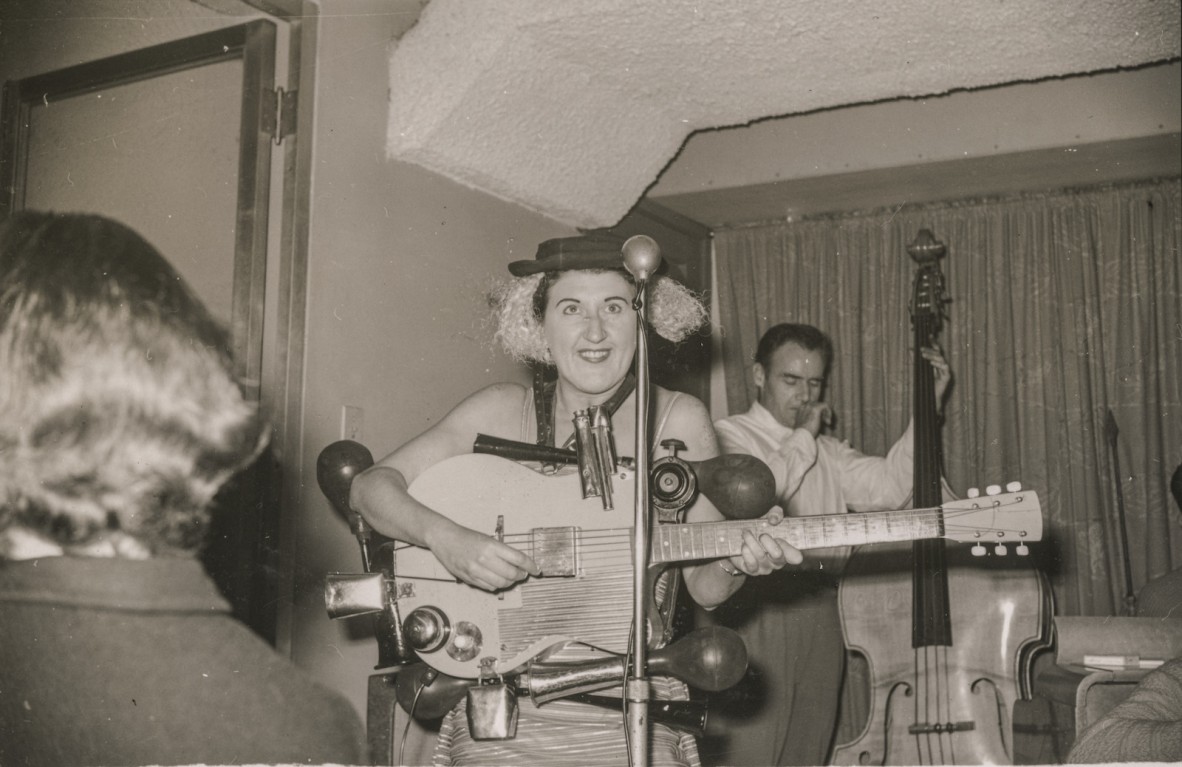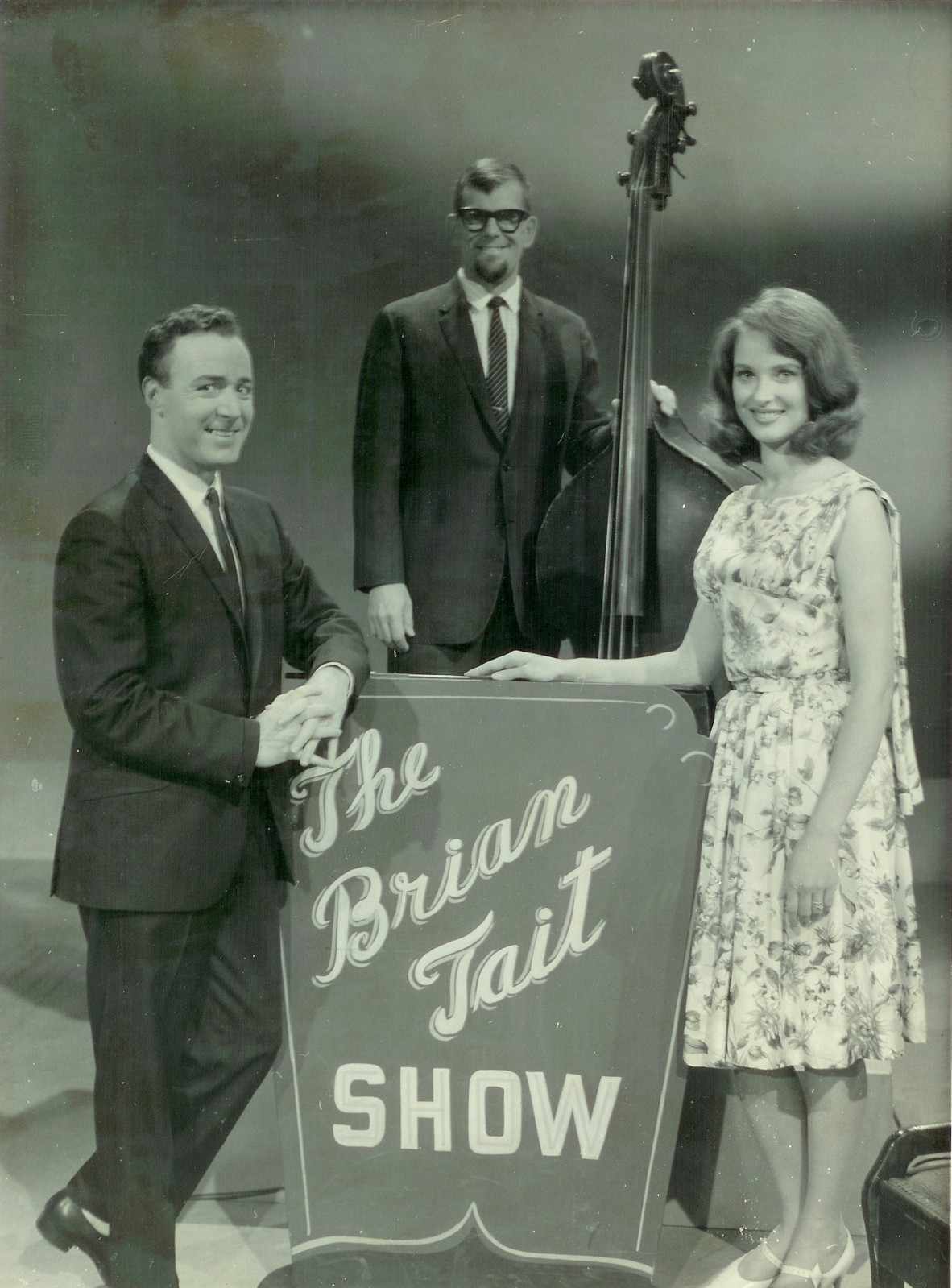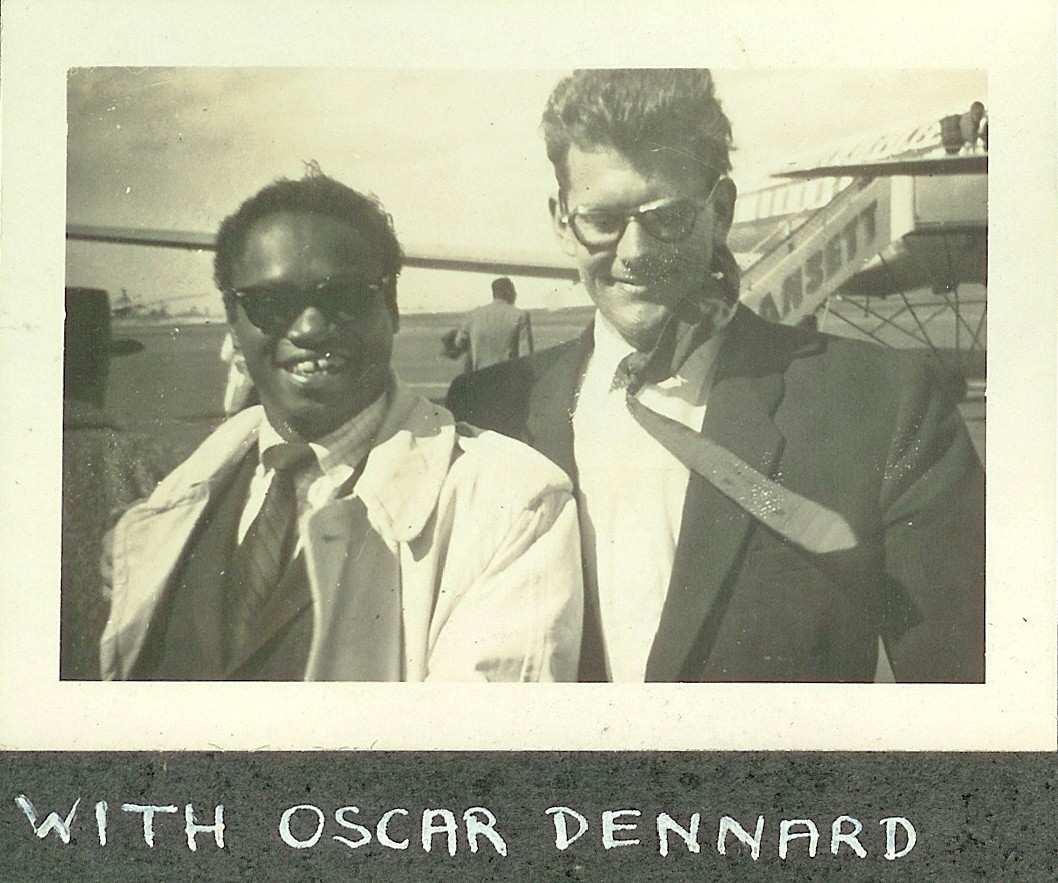Rick Farbach: Riding a musical wave from Riga to Surfers Paradise
By 2022 Letty Katts Fellow, Dr Leah Cotterell. | 2 February 2024
This blog was written by 2022 Letty Katts Fellow, Dr Leah Cotterell.
A wonderful cache of photographs of performers at The Primitif Coffee Lounge in the late 1950s is now available online through the State Library's catalogue, from the collection, 32929 Peter Hackworth photographs and ephemera. The nearly 200 photos from Peter Hackworth’s personal collection document a fascinating local music scene, captured through the camera lens of Kevin Anderson. The Letty Katts Fellowship has supported me to explore the stories of a number of the jazz musicians in these photos.
This blog will focus on musician, arranger and musical director, Rick Farbach. Rick’s musical life spanned fifty plus years of change, shaped by international stylistic movements, world wars, demographic shifts and technological breakthroughs. Riding the crest of these waves with energy and ingenuity, his achievements represent a unique contribution to music in Queensland.
Peter’s collection includes this modernist handbill from the early 1960s, which gives Rick’s name (misspelled) as playing guitar and bass in the Sunday night house band.
Handbill for the Sunday night Jazz Workshop, Primitif Coffee Lounge. 32929 Peter Hackworth photographs and ephemera, John Oxley Library, State Library of Queensland
Although there is no photo of Rick playing at The Primitif in Peter Hackworth’s collection, as one of the outcomes of the Letty Katts Fellowship, Rick’s souvenir scrapbooks have been donated to the State Library by his children in 2023. There’s a glimpse of those images in this blog, and more in this musical montage accompanied by Rick’s own arrangement of the Latin jazz standard “Poinciana”:
Poinciana - celebrating Rick Farbach by Leah Cotterell, YouTube.
And we are lucky that Rick Farbach published his own memoir in 1999, available in State Library's collection. ‘Cleftomania’ is colourful and funny, painting a vivid picture of how music flourished in Brisbane and at the Gold Coast in the 1950s and 1960s, strongly influenced by American jazz and by the influx of migrants, like himself, leaving war torn Europe to settle in Australia.
Rick grew up in Riga in a well-off family with strong musical traditions. As a child he studied classical piano but in his youth became a fan of American popular music, in particular, jazz guitar. Fleeing the Russian post-war occupation of Latvia, Rick was living in a displaced persons camp in Germany when he bought his first guitar and started to play in bands. In this era, electric guitars were changing the sound of popular music. For the first time guitarists were able to be heard playing lead lines and solos. By adapting the pick ups from some hearing aids, Rick retrofitted his own electric guitar. Sneaking across the border between British and US territory in pursuit of opportunities in Munich, Rick wound up playing for US service people who paid him in cigarettes and other rations.

Dance band at Café Boheme in Munich 1948; L-R Percy Farbach, Heinz Pfeiffer, Rick Farbach. From the collection of Rick Farbach.
Survival in Munich was a continuous struggle, so seeking a better life, in 1949 Rick migrated to Australia with his first wife and child. In return for free passage, he was bound for two years to a labour agreement that meant working a series of blue collar jobs. But he still managed to introduce himself to the Sydney music scene, jamming and working with professionals whenever possible and once free of constraints, becoming a full-time musician. Work in Sydney nightclubs meant ten hour shifts from sunset to sunrise and could include playing popular repertoire, accompanying floorshow acts, telling jokes and even dressing up in costume. In Sydney Rick also had the chance to explore recording and radio, writing arrangements for an LP that was an artistic success, though a commercial failure. Despite setbacks, he never wavered from his ambition to make music.

L-R Johnny Borg, Jack Craber, Ron Kebber, Rick Farbach, Billy Antman in Sydney mid 1950s. From the collection of Rick Farbach
Rick wrote about this time:
In many respects the 1950s were a special page in Australia’s history. Television had not yet arrived. There was a beautiful adult innocence wafting in the air. Australia’s population was exploding because of immigration…Popular music was going through a revolution…most people’s pockets jingled as they walked and people concentrated on embroidering new pleasures onto their already rich tapestry of life.
But the musicians’ lifestyle did not suit itself to fatherhood and by 1955 Rick had divorced.
The next stage in Rick’s story came with an invitation to lead a band at Bruno’s Windjammer Room at Surfers Paradise. Driving north in his 1928 Dodge he found a high street lined with hotels and nightclubs, a mecca for southern tourists in winter, and a permanent party where musicians were treated with respect. “Surfers Paradise was a very small town with big ideas and a reputation to match with a population like no other in Australia. Virtually every resident was a fully-fledged ‘character’” (p. 123). Being a bit of character himself, Rick stayed on, working a series of residencies.

Living on the Gold Coast meant Rick also had access to gigs in Brisbane and he was invited to lead the band at La Boheme nightclub in George Street. This was was a room for dining and dancing run by Baron George Weinsberg. George was an exotic personage, a lapsed Austrian Baron who loved entertaining his patrons by playing violin table to table and singing in a classical style (he had been tutored by Richard Tauber). In Rick’s time La Boheme became a hub where many of the musicians from The Primitif came to sit in with the excellent house band.
This is where Rick first met the 19 year old Peter Cox (later Hackworth) before her marriage to the much older George. In this period Rick also married his second wife, Dawn. They went on to have three children and were a dynamic couple until his death in 2005. Incidentally, Peter Cox sang Ave Maria at their wedding, the last time she sang in public (personal communication, January 9 2024).

The house band at La Boheme (circa 1956). L-R Jack Thompson clarinet, Rick Farbach guitar, Arthur Howard saxophone, Jim Reilly piano, Lloyd Adamson trumpet. From the collection of Rick Farbach
Once again, at the vanguard of professional music, when the first Brisbane TV station, Channel 7 started broadcasting from Mount Coot-tha in 1959, Rick was recruited to play for “Theatre Royal” a program hosted by comedian George Wallace Junior. The TV show was a direct transfer of the kinds of the vaudeville acts presented at the actual Theatre Royal in Elizabeth Street. Wallace had been the headline act there for nearly two decades until 1957. After he left, despite the appeal of the “undraped models” in their final program (titled “Nudie Follies”) the Theatre Royal closed in 1959 (Bollen, 2011).
Among the artists photographed at The Primitif there are a large number of vaudeville style acts. There are ventriloquists, puppeteers, female impersonators, exotic dancers and many comics, including Barry Crocker and Rita Schneider. Peter says they gravitated to the The Primitif as the only show in town on Sunday nights. I wonder how many of these performers were scouring Australia for any opportunity to play as vaudeville was rapidly being superceded by new formats. This might be an interesting subject for further research.

Guitarist Darcy Kelly watches a contortionist’s act at The Primitif. 32929, Peter Hackworth photographs and ephemera, John Oxley Library, State Library of Queensland. Image number: 32929-0001-0218.

Rita Schneider at The Primitif . 32929, Peter Hackworth photographs and ephemera, John Oxley Library, State Library of Queensland. Image number: 32929-0001-0181.
The cast of the “Theatre Royal” TV show included Brian Tait who went on to host his own live TV show with Rick as the musical director. Rick’s work in TV would flourish for nearly two decades and for a time he was the musical director of bands at all three local television stations.

Rick on The Brian Tait Show, early 1960s. From the collection of Rick Farbach.
From an artistic perspective, Rick’s personal highpoint as a musician was the invitation to tour with Stan Kenton’s big band in 1957. He writes about his satisfaction in playing and jamming with the cream of American musicians, “…the tour had been a marvellous learning experience. I had discovered a lot that I didn’t know before. This tour was a valuable boon to my musical education, So much so that Dawn and I decided that, should we ever have a son, we would call him Kenton (which we did)” (p.174).

Rick with pianist Oscar Dennard while on tour with Stan Kenton in 1957. From the collection of Rick Farbach.
Rick Farbach was a living, breathing connection between the Queensland jazz scene and the wider musical world. His work spanned great changes, from the years before the guitar was electrified to the era when music became digitised. He was there in the early days of an Australian recording industry and right on the spot at the beginning of television. His memoir enhances our understanding of live performance from moments of wonderfully eccentric showmanship to music fastidiously arranged for live broadcast. In every manifestation Rick was motivated by the desire to make good music.

Rick Farbach at The Cha Cha Cha, Surfers Paradise 1960. From the collection of Rick Farbach.
Rick Farbach’s contribution to jazz at The Primitif was as a senior player sharing his skills and knowledge. This was an important role and a real testament to the quality and generosity of our local music culture.
Dr Leah Cotterell, 2022 Letty Katts Fellow.
If you have any photographs, ephemera or other material related to The Primitif Cafe, please consider donating it to our John Oxley Library collection. Please contact qldmemory@slq.qld.gov.au.
Collections
- 32929 Peter Hackworth photographs and ephemera
- 34130 Rick Fabach scrapbooks and photographs
- Farbach, R (1999). Cleftomania: a disease that attacks musicians and makes them do strange things. Oracle Press, 1999.
Other Links
- Bollen, J. (2011, April 3). Theatre Royal, Brisbane: Research on performance and desire.
- Rita Schneider Obituary (2009, April 13) Singing sister a TV pioneer. The Sydney Morning Herald.
Other blogs by Dr Leah Cotterell
- Jazz, the beating heart of The Primitif
- The Primitif Coffee Shop: young, hip and gorgeous in 1950s Brisbane
- Peter Hackworth and The Primitif: An origins story
- Rick Farbach: Riding a musical wave from Riga to Surfers Paradise
- From satin gowns to jazz advocacy – remembering Paula Langlands
- Research Reveals 2024
- Loving Lloyd : A brief biography of Lloyd Adamson (b.1929 Bryon Bay, d.1975 Sydney
Comments
Your email address will not be published.
We welcome relevant, respectful comments.